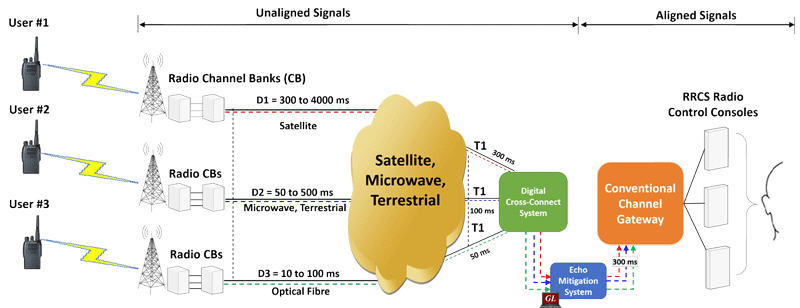Different backhaul networks and need for Echo Mitigation System to Synchronize Inbound and Outbound Audio.
GL's Echo Mitigation System deployed on the backhaul system.

GL Communications Inc. a global leader in telecom test and measurement solutions, announced today its Echo Mitigation System (EMS) Software that can be deployed on the backhaul systems to eliminate the varying delay/echo resulting from different backhaul technologies used to transport audio through the system.
Speaking to the press, Mr. Vijay Kulkarni, the CEO of the company said, “Variations in delay can potentially cause gaps in the speech. The greater the time discrepancy between audio signals, the more difficult to understand the message. Echo Mitigation System (EMS) by GL Communications can be deployed on the backhaul system to eliminate the delay/echo.”
He added, “EMS solution allows for the measurement of delay from each site of a group of radio sites as well as the application of offsetting delays to mitigate the echo impairment.
During the echo mitigation process, a user configurable delay is applied to each DS-0 in each T1 for east and west directions (48 DS0s / per duplex T1) and each DS-0 may be configured with its own delay parameter. This helps to synchronize inbound and outbound audio delivered to end users (or dispatch operators). For example, in an Octal T1 system, all 192 DS0s / all T1s (8 T1s) can be applied user configurable delays.”
Mr. Kulkarni further explained, “When a carrier provided DS0 circuit is placed into loopback at a remote site, the system will be able to initiate a circuit delay test on that DS0. EMS Software performs round-trip delay measurements. One-Way delay measurement available using companion equipment This measurement will facilitate the configuration of the circuit delays required to bring the audio signals into sync. The EMS software contains a configuration utility through which users specify delay values.EMS functionality can be enabled or disabled at both DS1 and DS0 levels.”
He added, “The system will be able to inject circuit delays without degrading or disrupting communications using the standard timings of 3.0 ms on a D4 format circuit, and 6.0 ms on ESF format. Minimum delay steps 3 milliseconds in ESF mode. Delay is implemented via a delay buffer scheme with the ability to add circuit delays independently in the transmitting and receiving paths of a DS0. The user interface will also provide the ability to assign DS0 and DS1 circuits names for extended information to identify the circuits. “
GL has related applications that allows applying delay, attenuation, and/or filtering to a received signal on any number of timeslots, or apply delay, attenuation (gain), and/or filtering to a received signal on a single timeslot, and measure and display Loop Delay and Echo Return Loss (ERL) on one or more timeslots.”








.png)


.jpg)

Comments
There are no comments yet for this item
Join the discussion